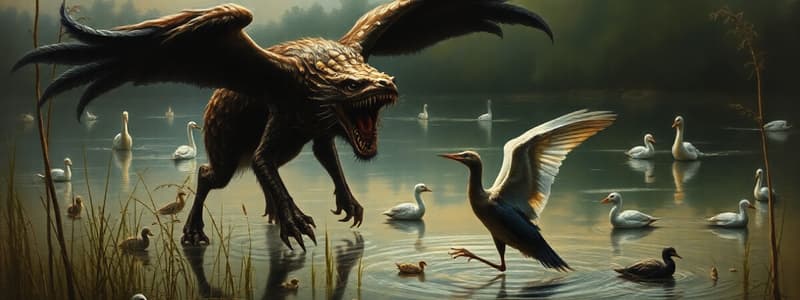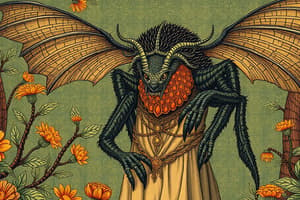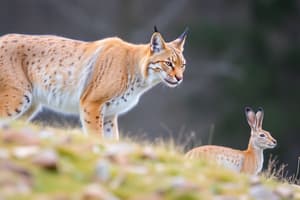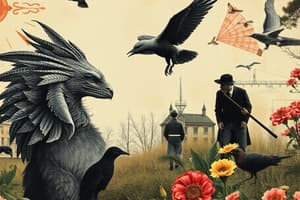Podcast
Questions and Answers
How does the coloration of the Strawberry Poison Dart Frog serve as a protective adaptation?
How does the coloration of the Strawberry Poison Dart Frog serve as a protective adaptation?
- It changes color to match the predator's appearance, deterring any attacks.
- It uses camouflage to blend in with its environment, making it difficult for predators to spot.
- It mimics the coloration of non-toxic frogs, confusing predators about its true nature.
- It uses warning coloration to signal its toxicity to potential predators. (correct)
In what way does a skunk's defense mechanism differ from that of a deer, based on the information provided?
In what way does a skunk's defense mechanism differ from that of a deer, based on the information provided?
- The skunk displays warning coloration, while the deer uses mimicry.
- The skunk communicates with its group, while the deer remains solitary.
- The skunk sprays a chemical, while the deer employs camouflage. (correct)
- The skunk relies on camouflage, while the deer uses offensive techniques.
What is the primary benefit for prey species that utilize communication techniques, such as vocalized signals or vibrations?
What is the primary benefit for prey species that utilize communication techniques, such as vocalized signals or vibrations?
- To warn each other of potential dangers and increase chances of survival. (correct)
- To attract predators away from other prey.
- To establish dominance hierarchies within the group.
- To coordinate hunting strategies against predators.
How does Mullerian mimicry, as exemplified by Monarch and Viceroy butterflies, enhance survival?
How does Mullerian mimicry, as exemplified by Monarch and Viceroy butterflies, enhance survival?
How does Batesian mimicry differ from Mullerian mimicry in terms of the species involved?
How does Batesian mimicry differ from Mullerian mimicry in terms of the species involved?
Compared to species that utilize chemical defenses, what is a common characteristic of animals that use chemicals for defense, like the skunk?
Compared to species that utilize chemical defenses, what is a common characteristic of animals that use chemicals for defense, like the skunk?
How might a population of prey animals that communicates warnings of predators be more successful than one that does not?
How might a population of prey animals that communicates warnings of predators be more successful than one that does not?
Which statement best describes the relationship between coevolution and predator-prey interactions?
Which statement best describes the relationship between coevolution and predator-prey interactions?
In the context of predator-prey relationships, how would you classify a zebra eating grass?
In the context of predator-prey relationships, how would you classify a zebra eating grass?
Why is predation considered a strong selective force for prey organisms?
Why is predation considered a strong selective force for prey organisms?
Which of the following is the MOST likely evolutionary response of a prey species to a new, highly efficient predator?
Which of the following is the MOST likely evolutionary response of a prey species to a new, highly efficient predator?
A population of rabbits is introduced to an island without natural predators. Initially, the rabbit population grows exponentially. However, after a few years, the growth rate slows down. Which factor is LEAST likely to contribute to the slowing growth rate?
A population of rabbits is introduced to an island without natural predators. Initially, the rabbit population grows exponentially. However, after a few years, the growth rate slows down. Which factor is LEAST likely to contribute to the slowing growth rate?
A species of bird develops a mutation that makes its beak more efficient at cracking open a specific type of seed. Over time, the seeds of this plant evolve to have thicker shells. What is this an example of?
A species of bird develops a mutation that makes its beak more efficient at cracking open a specific type of seed. Over time, the seeds of this plant evolve to have thicker shells. What is this an example of?
How does camouflage benefit predators?
How does camouflage benefit predators?
Which of the following scenarios best illustrates a predator employing camouflage as a hunting strategy?
Which of the following scenarios best illustrates a predator employing camouflage as a hunting strategy?
Flashcards
What is a Predator?
What is a Predator?
An animal that captures and eats another organism.
What is Prey?
What is Prey?
An organism that is captured and eaten by a predator.
What is Predation?
What is Predation?
The process where one organism (predator) hunts, captures, and eats another (prey).
What is Herbivory?
What is Herbivory?
Signup and view all the flashcards
What is a Carnivorous Predator?
What is a Carnivorous Predator?
Signup and view all the flashcards
What is an Herbivorous Predator?
What is an Herbivorous Predator?
Signup and view all the flashcards
What is Coevolution?
What is Coevolution?
Signup and view all the flashcards
What is Camouflage?
What is Camouflage?
Signup and view all the flashcards
Prey Camouflage
Prey Camouflage
Signup and view all the flashcards
Prey Communication
Prey Communication
Signup and view all the flashcards
Offensive Techniques (Prey)
Offensive Techniques (Prey)
Signup and view all the flashcards
Warning Coloration
Warning Coloration
Signup and view all the flashcards
Mimicry
Mimicry
Signup and view all the flashcards
Batesian Mimicry
Batesian Mimicry
Signup and view all the flashcards
Mullerian Mimicry
Mullerian Mimicry
Signup and view all the flashcards
Study Notes
- Predator-prey interactions are a crucial element in the structure of ecosystems.
- A predator is an organism that captures and consumes another organism, while prey is the organism that is captured and eaten.
- Predation is the process where one organism hunts, captures, and eats another.
Types of Predators
- Predators can be carnivores or herbivores.
- Herbivory occurs when the prey is a plant.
- A lion capturing a zebra is an example of a carnivorous predator.
- A zebra eating grass is an example of an herbivorous predator.
- Predators are usually larger than their prey.
- Most predators target specific prey, but some consume a wide range of organisms.
Types of Prey
- Prey can be animals or plants, depending on the predator.
- In the lion and zebra example, both the zebra and the grass are types of prey.
- Prey must develop adaptations to survive predation.
Predator-Prey Interactions, Adaptations, and Examples
- Predation is a strong selective force for prey organisms.
- Predators and prey are always adapting, leading to coevolution.
- Coevolution occurs when the fitness of two species is linked, and they evolve in response to changes in each other.
- An example of coevolution is lions evolving to become faster to catch zebras, and zebras becoming faster to avoid being eaten.
Camouflage of Prey and Predators
- Camouflage is a common adaptation where body shape and coloration help an organism blend into its environment.
- Polar bears use their white fur to camouflage in snowy environments, making it easier to capture prey.
- Deer use their brown fur and spots to blend in with wooded environments, avoiding predators.
Communication Techniques of Prey
- Prey organisms may use communication techniques to warn each other of predators.
- Species using these techniques often live in groups for protection.
- Vervet monkeys use different vocal signals for different predators, warning the troop of danger.
- Honeybees use vibrations to warn others in the hive of predators.
- Prairie dogs stomp their feet as a warning signal.
Offensive Techniques of Prey
- Offensive techniques are prey adaptations that utilize behavior or physical features for protection.
- Skunks spray chemicals to ward off predators and rarely use camouflage.
- Cactus plants use spikes to prevent being eaten by animals.
Warning Coloration
- Warning coloration involves using specialized body coloration to warn group members of dangerous predators.
- The coloration can warn predators of toxicity or give a false impression to deter them.
- The strawberry poison dart frog is brightly colored red to warn predators of its toxicity.
Mimicry
- Mimicry is when one species evolves to resemble another species that is toxic or dangerous.
- The organism itself may not be dangerous.
- Batesian mimicry occurs when a harmless organism mimics the warning coloration of a harmful species.
- The robber fly looks like a bumblebee, deterring predators.
- Mullerian mimicry is when two different species share the same warning coloration.
- Monarch and Viceroy butterflies have similar colors to warn predators of their unpleasant taste.
Studying That Suits You
Use AI to generate personalized quizzes and flashcards to suit your learning preferences.




